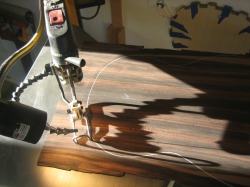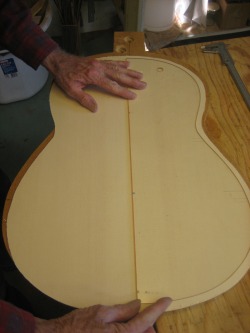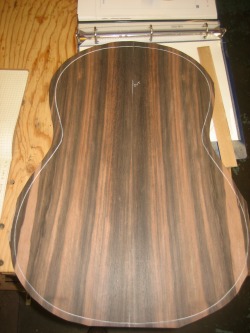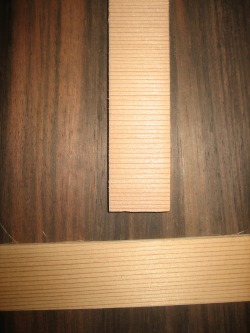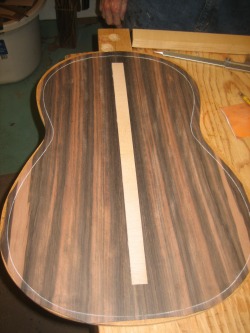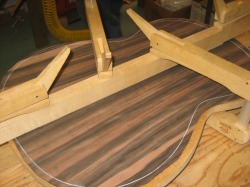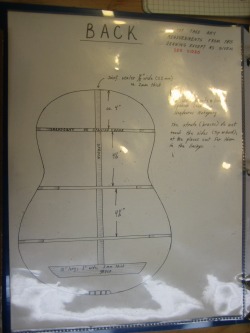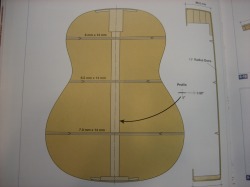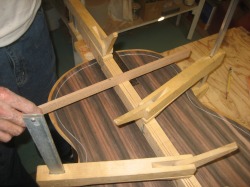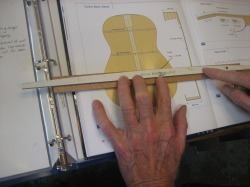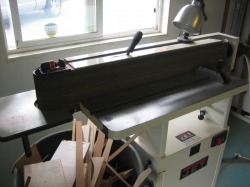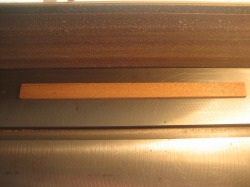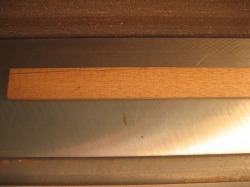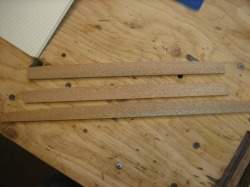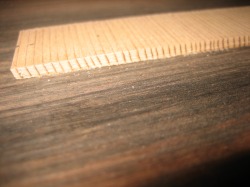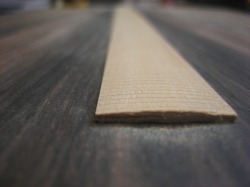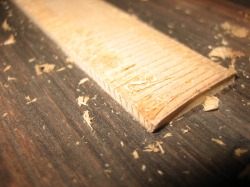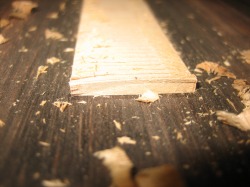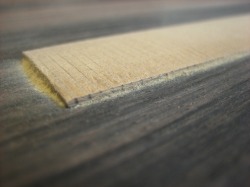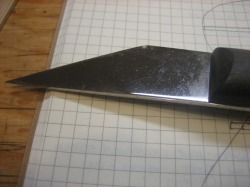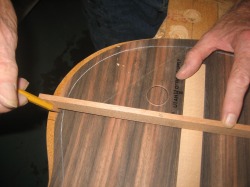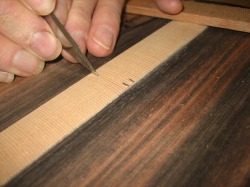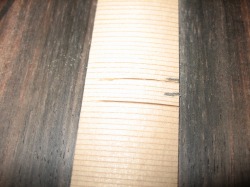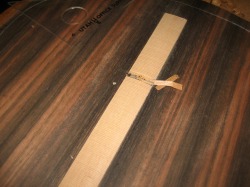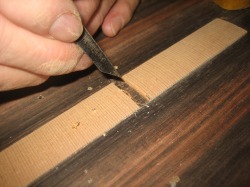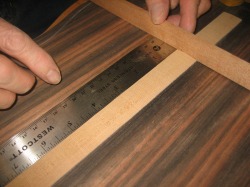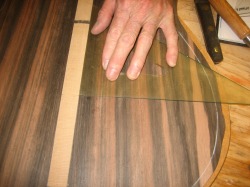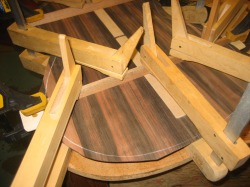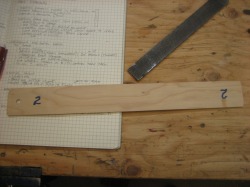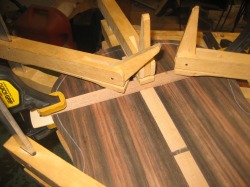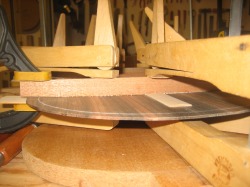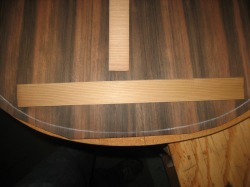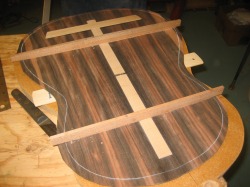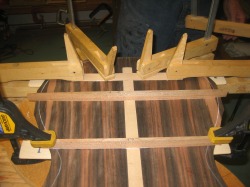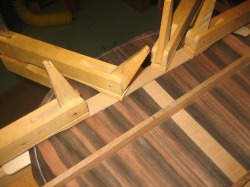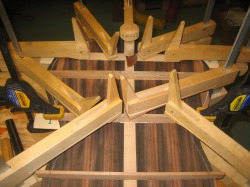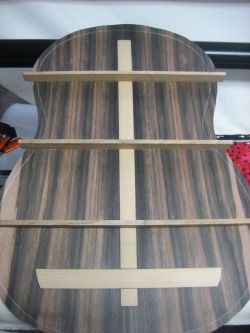< Work Day 1 Work Day 3>
Work Day #2 - October 7th, 2008 (4 hrs)
Today we continued work on the back. But before that, we cut out both the top and back.
When the top and back are cut, you want to leave an edge of about 10mm-15mm around the drawn pattern.
Ok...on to the back. The first piece to be applied is a vertical brace that runs along the seam. The brace is made from two pieces of Spanish cedar glued together. The vertical brace should have the grain running perpendicular to the grain of the back. This brace is 3mm thick by about 30mm wide and the length varies. But it should start about 1 inch from the top of the back to about 2-3 inches from the bottom.
Apply an even coat of glue to the brace and center it exactly over the seam of the two back halves. Place a piece of wood over the brace then clamp in place. Take care when clamping as setting the clamps can cause the brace to shift.
If the right amount of glue has been applied, you should see a little leaking out of the side of the brace...a little...not a lot. Let that excess glue dry for a few minutes then use a chisel to scrape it away.
This leaves the inside of the back a clean and professional look. You never know when someone will take a mirror and look inside your finished guitar. This is similar to your mom always telling you to put on clean underwear...you never know when you might end up visiting the emergency room!
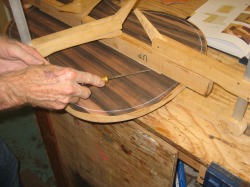
Scraping the excess glue w/ a small chisel.
While the vertical brace dried, we moved on to the horizontal braces. For this guitar, mahogany will be used. The horizontal braces range from 6mm thick to 7mm thick. Brace 1 (starting from the top of the back) is 6mm thick and about 14mm tall and will be placed approx 4 inches from the top. Brace 2 is 6.5mm thick, 14mm tall and will be 4.5 inches below brace 1. Finally, brace 3 is 7mm thick, 14mm tall and will be 4.5 inches below brace 2.
From what my dad says, it seems like the bracing is largely subjective. Some guys will do 5mm thick braces that are taller...like 18mm. Others will use 6mm thick bracing on all 3. And the type of wood used varies as well. Dad suggested the mahogany as it is a nice hard wood and the pieces we used are aged enough to have the strength we want.
Dad told me about a back he had done where he had to remove and replace all the bracing on the back because it weakened and caused the back to lose its curve.
Dad already had the bracing sized so we just needed to cut it to length. We simply set the horizontal brace over the vertical brace and cut it so it would extend a 5mm over each edge of the back. We did this for all 3 braces.
Now with the vertical brace glued we removed the clamps and started shaping it. Here is a before and after look:
The finished brace will have a slight curve to it but you don't what to thin the edge flush w/ the back, you want to leave a .5mm edge.
To shape the brace we used a combination of a mini-planer, chisel, rasp file, and sandpaper (100, 150, and 220 grit). Dad uses the chisel to remove most of the material and give the brace the curve. But a chisel requires a steady hand a feel for the wood...neither of which I really have right now! So I used the mini-planer then moved to the sandpaper. Starting w/ 100 grit then 150 and finishing w/ 220.
With the vertical brace shaped, it's time to cut the grooves for the horizontal braces.
Starting at the top, we measure down 4" and mark the width of the horizontal brace on the vertical brace. To make sure the brace is a perfectly perpendicular, we use a triangle square when marking the lines. The lines can be drawn with a sharp pencil or a marking knife shown below. Mark the lines on the vertical brace where the groove will be cut, and a mark at both edges of the back to help with alignment when it comes time to glue the horizontal braces to the back.
The lines can be drawn with a sharp pencil or a flat edge marking knife shown here. These knives are sold as a left and right pair. One side of the knife is straight and the other has the bevel for the edge.
With the lines drawn perfectly straight we took a sharp cutting knife and cut on the lines. Be careful not to use too much pressure to cut into the back. You only want to cut the brace.
With a sharp and narrow (3mm) chisel, carefully chisel out the cut section of the vertical brace. We used the chisel as a scraper as well to clean off any glue and to make the edges clean and straight.
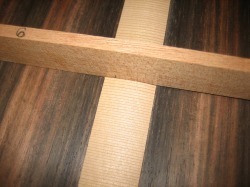
The finished groove should allow the horizontal brace to easily slide down and contact the back.
With the 1st groove finished, we moved on the the 2nd and 3rd. The 2nd groove will be 4.5" below the 1st groove. And the 3rd groove 4.5" below the 2nd.
Each horizontal brace is a different thickness, so make sure to use the correct brace when marking the lines for the width of the groove. As you can see in the picture, a "6" is penciled onto the brace which identifies it as the 6mm brace (the first one from the top).
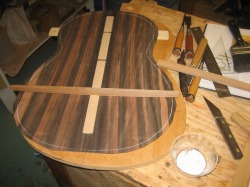
All 3 grooves cut...we're ready for glue.
With the glue applied to the curved side of the brace we dropped it into the groove. Make sure to line up the ends w/ the marks at the edge of the back made when marking the lines to cut the groove.
We glued the top and bottom brace first and let the glue set up for at least an hour before removing the clamps and moving to the center brace. Also, don't forget to scrape off the excess glue (after it sets up for about 10 minutes) that squeezes out under the pressure of the clamps.
We used thin pieces of wood between the clamps and the back as tightening the clamps draws the back around the curve of the horizontal braces so the pieces need to be flexible and we wanted the clamps to not rest directly on the outside of the back.
Before gluing the center brace, we prepared a brace that Hannabach uses to prevent splitting from the bottom of the back. This piece is 2mm thick and varies in length. Ours is approx. 9" wide and 1.5" wide. The piece started as a rectangle, and we added a bit of a curve to each end...just for decoration. We also tapered the edges slightly as seen in the picture above.
Once the piece was shaped, we again made the marks on the vertical brace to cut out the groove where this final brace would be placed. This brace was placed about 3" up from the bottom of the back.
With the bottom groove ready, we clamped both the thin bottom brace and the center horizontal brace. For the center brace, we again used the thin wood guide to clamp against.
And that's where we ended on work day #2. After the glue set up for an hour or so, Dad removed the clamps and set it aside to be finished later.
We've decided to shape the horizontal braces after we have the top, neck and sides ready to go. We want to ensure the curve of the back will stay as it is now, and leaving the horizontal braces alone will help.
